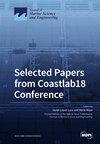海洋环境中海水电解防污和冲击电流阴极保护 (ICCP) 联合保护下的 EH36 表面沉积层研究
IF 2.7
3区 地球科学
Q1 ENGINEERING, MARINE
引用次数: 0
摘要
构建了海水电解防污和 ICCP 的联合保护装置,并进行了对比实验,以研究海洋环境中联合保护下 EH36 表面沉积层的成分。对实验样品的表面沉积层进行了表面形貌分析、能量色散光谱(EDS)成像分析和 X 射线衍射(XRD)成分分析。实验结果表明,在联合保护条件下,EH36 表面迅速形成了隔离海水介质的沉积层,该沉积层主要由 Mg(OH)2 和少量 CaCO3 组成。EH36 基质表面没有腐蚀。只使用 ICCP 时,EH36 表面沉积了一层相对较薄的钙镁层。海洋污损生物附着在钙镁沉积层和 EH36 底材表面,它们的附着影响了钙镁沉积层的形成。此外,海洋污损生物还会对 EH36 底材表面造成腐蚀。海水电解防污和 ICCP 的联合保护可同时防止 EH36 表面的电化学腐蚀和海洋生物垢腐蚀。本文章由计算机程序翻译,如有差异,请以英文原文为准。
A Study of the EH36 Surface Sediment Layer under Joint Protection from Seawater Electrolysis Antifouling and Impressed Current Cathode Protection (ICCP) in a Marine Environment
A joint protection device for seawater electrolysis antifouling and ICCP was constructed, and comparative experiments were conducted to study the composition of the EH36 surface deposition layer under joint protection in a marine environment. Surface morphology analysis, energy-dispersive spectroscopy (EDS) imaging analysis, and X-ray diffraction (XRD) composition analysis were performed on the surface deposition layers of the experimental samples. The experimental results showed that under joint protection, a sedimentary layer was rapidly formed on the surface of EH36 to isolate the seawater medium, and this layer was mainly composed of Mg(OH)2 and a small amount of CaCO3. There was no corrosion on the surface of the EH36 substrate. When only ICCP was used, a relatively thin layer of calcium magnesium was deposited on the surface of EH36. Marine fouling organisms adhere to the surface of calcium and magnesium sedimentary layers and the EH36 substrate, and their attachment affects the formation of calcium and magnesium sedimentary layers. Moreover, marine fouling organisms cause corrosion on the surface of the EH36 substrate. The joint protection of seawater electrolysis antifouling and ICCP can simultaneously prevent electrochemical corrosion and marine biological fouling corrosion on the surface of EH36.
求助全文
通过发布文献求助,成功后即可免费获取论文全文。
去求助
来源期刊

Journal of Marine Science and Engineering
Engineering-Ocean Engineering
CiteScore
4.40
自引率
20.70%
发文量
1640
审稿时长
18.09 days
期刊介绍:
Journal of Marine Science and Engineering (JMSE; ISSN 2077-1312) is an international, peer-reviewed open access journal which provides an advanced forum for studies related to marine science and engineering. It publishes reviews, research papers and communications. Our aim is to encourage scientists to publish their experimental and theoretical results in as much detail as possible. There is no restriction on the length of the papers. The full experimental details must be provided so that the results can be reproduced. Electronic files and software regarding the full details of the calculation or experimental procedure, if unable to be published in a normal way, can be deposited as supplementary electronic material.
 求助内容:
求助内容: 应助结果提醒方式:
应助结果提醒方式:


